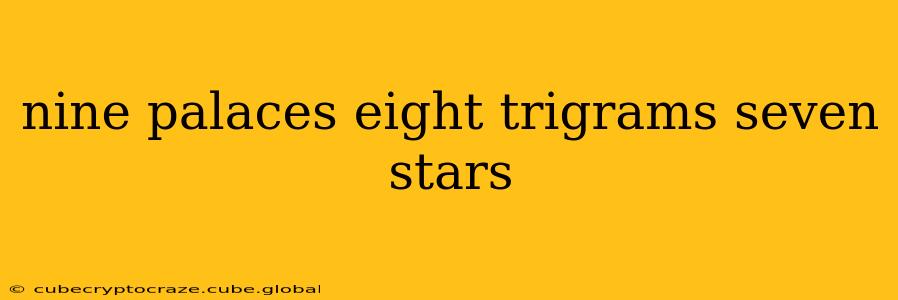The phrase "Nine Palaces, Eight Trigrams, Seven Stars" evokes a sense of ancient wisdom and mystical power. These three elements are fundamental components of Chinese metaphysics, offering a fascinating glimpse into a worldview deeply connected to nature, cosmology, and human destiny. This exploration will delve into each element, revealing their individual significance and interconnectedness within the larger framework of Chinese philosophical thought.
What are the Nine Palaces?
The Nine Palaces (九宮, Jiǔ Gōng) refer to a 3x3 grid used in various divination practices, including feng shui and numerology. Each palace represents a specific direction, element, and energy. This grid is often overlaid on a map or a building plan to analyze the flow of Qi (vital energy) and its influence on the inhabitants. Understanding the Nine Palaces allows practitioners to optimize the environment for harmony and prosperity. The arrangement of numbers and their associated energies is key to interpreting the implications for a particular location or time period.
How are the Nine Palaces used in Feng Shui?
In Feng Shui, the Nine Palaces are used to determine auspicious directions for various activities, such as sleeping, working, or placing specific objects. The arrangement of the palaces changes annually, based on the flying stars system, further emphasizing the dynamic nature of energy flow. By understanding the yearly changes, practitioners can adapt their environment to maximize positive energy and minimize negative influences. This isn't simply about arranging furniture; it's about aligning oneself with the beneficial energies prevalent in a given year.
What are the Eight Trigrams?
The Eight Trigrams (八卦, Bāguà) are eight symbolic representations composed of three lines, each either solid (yang) or broken (yin). These trigrams symbolize fundamental forces and aspects of reality, forming the basis of the I Ching, a classic text of Chinese divination. Each trigram represents a specific element (metal, wood, water, fire, earth), a season, a family member, and even aspects of personality.
How do the Eight Trigrams relate to the I Ching?
The Eight Trigrams are the building blocks of the 64 hexagrams in the I Ching. Each hexagram is formed by combining two trigrams, creating a more complex representation of the interplay between yin and yang energies. Consultations of the I Ching, often using methods like yarrow stalks or coins, reveal a hexagram that offers guidance and insights into a specific situation or question. The interpretation of these hexagrams and their associated trigrams relies on a deep understanding of their symbolic meanings and relationships.
What are the Seven Stars?
The Seven Stars (七星, Qī Xīng) typically refer to the seven major stars in the Big Dipper (北斗七星, Běidǒu Qī Xīng) constellation. In Chinese astrology and metaphysics, these stars are associated with different aspects of life, fortune, and destiny. Their positions and movements are believed to influence human affairs and earthly events.
How are the Seven Stars used in divination?
Similar to the Nine Palaces and Eight Trigrams, the Seven Stars are incorporated into various divination practices. Their positions relative to each other and other celestial bodies are analyzed to gain insight into the future and understand potential challenges or opportunities. The precise interpretation often involves complex calculations and a deep understanding of celestial mechanics and their symbolic associations.
The Interconnectedness of Nine Palaces, Eight Trigrams, and Seven Stars
While each system—Nine Palaces, Eight Trigrams, and Seven Stars—possesses its unique application and significance, they are interconnected within the broader framework of Chinese metaphysics. They all represent different ways of understanding and interacting with the underlying principles governing the universe. They share a common thread: the belief in a dynamic interplay between yin and yang, the five elements, and the constant flux of cosmic energies. Understanding these connections provides a more holistic understanding of Chinese cosmology and its influence on human experience.
This exploration merely scratches the surface of the rich and complex world of Chinese metaphysics. Further research into individual elements will unveil even deeper layers of meaning and application within this fascinating tradition.
